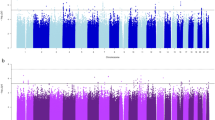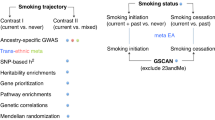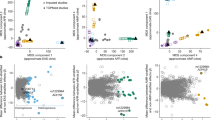Abstract
Common genetic variants explain less variation in complex phenotypes than inferred from family-based studies, and there is a debate on the source of this ‘missing heritability’. We investigated the contribution of rare genetic variants to tobacco use with whole-genome sequences from up to 26,257 unrelated individuals of European ancestries and 11,743 individuals of African ancestries. Across four smoking traits, single-nucleotide-polymorphism-based heritability (\(h^2_{\mathrm{SNP}}\)) was estimated from 0.13 to 0.28 (s.e., 0.10–0.13) in European ancestries, with 35–74% of it attributable to rare variants with minor allele frequencies between 0.01% and 1%. These heritability estimates are 1.5–4 times higher than past estimates based on common variants alone and accounted for 60% to 100% of our pedigree-based estimates of narrow-sense heritability (\(h^2_{\mathrm{ped}}\), 0.18–0.34). In the African ancestry samples, \(h^2_{\mathrm{SNP}}\) was estimated from 0.03 to 0.33 (s.e., 0.09–0.14) across the four smoking traits. These results suggest that rare variants are important contributors to the heritability of smoking.
This is a preview of subscription content, access via your institution
Access options
Access Nature and 54 other Nature Portfolio journals
Get Nature+, our best-value online-access subscription
$29.99 / 30 days
cancel any time
Subscribe to this journal
Receive 12 digital issues and online access to articles
$119.00 per year
only $9.92 per issue
Buy this article
- Purchase on Springer Link
- Instant access to full article PDF
Prices may be subject to local taxes which are calculated during checkout



Similar content being viewed by others
Data availability
Phenotypes are available through an authorized access portal in dbgap (https://dbgap.ncbi.nlm.nih.gov/) or direct request to TOPMed principal investigators. Accession numbers and email addresses of the principal investigators are presented in the Supplementary Note. Genetic data are available through the dbgap TOPMed exchange area.
Code availability
All software used is publicly available and can be found at the references cited.
References
Johnson, T. & Barton, N. Theoretical models of selection and mutation on quantitative traits. Phil. Trans. R. Soc. B 360, 1411–1425 (2005).
Keinan, A. & Clark, A. G. Recent explosive human population growth has resulted in an excess of rare genetic variants. Science 336, 740–743 (2012).
Yengo, L. et al. Meta-analysis of genome-wide association studies for height and body mass index in ∼700000 individuals of European ancestry. Hum. Mol. Genet. 27, 3641–3649 (2018).
Graham, S. E. et al. The power of genetic diversity in genome-wide association studies of lipids. Nature 600, 675–679 (2021).
Vujkovic, M. et al. Discovery of 318 new risk loci for type 2 diabetes and related vascular outcomes among 1.4 million participants in a multi-ancestry meta-analysis. Nat. Genet. 52, 680–691 (2020).
Ripke, S. et al. Biological insights from 108 schizophrenia-associated genetic loci. Nature 511, 421–427 (2014).
Manolio, T. A. et al. Finding the missing heritability of complex diseases. Nature 461, 747–753 (2009).
Ezzati, M., Lopez, A. D., Rodgers, A., Vander Hoorn, S. & Murray, C. J. Selected major risk factors and global and regional burden of disease. Lancet 360, 1347–1360 (2002).
Reitsma, M. B. et al. Smoking prevalence and attributable disease burden in 195 countries and territories, 1990–2015: a systematic analysis from the Global Burden of Disease Study 2015. Lancet 389, 1885–1906 (2017).
Carter, B. D. et al. Smoking and mortality—beyond established causes. N. Engl. J. Med. 372, 631–640 (2015).
Maes, H. H. et al. A genetic epidemiological mega analysis of smoking initiation in adolescents. Nicotine Tob. Res. 19, 401–409 (2017).
Vink, J. M. & Boomsma, D. I. Interplay between heritability of smoking and environmental conditions? A comparison of two birth cohorts. BMC Public Health 11, 316 (2011).
Quach, B. C. et al. Expanding the genetic architecture of nicotine dependence and its shared genetics with multiple traits. Nature communications 11, 1–13 (2020).
Degenhardt, L. & Hall, W. The relationship between tobacco use, substance-use disorders and mental health: results from the National Survey of Mental Health and Well-Being. Nicotine Tob. Res. 3, 225–234 (2001).
McCabe, S. E., West, B. T. & McCabe, V. V. Associations between early onset of e-cigarette use and cigarette smoking and other substance use among US adolescents: a national study. Nicotine Tob. Res. 20, 923–930 (2018).
King, S. M., Iacono, W. G. & McGue, M. Childhood externalizing and internalizing psychopathology in the prediction of early substance use. Addiction 99, 1548–1559 (2004).
Polderman, T. J. C. et al. Meta-analysis of the heritability of human traits based on fifty years of twin studies. Nat. Genet. 47, 702–709 (2015).
Liu, M. et al. Association studies of up to 1.2 million individuals yield new insights into the genetic etiology of tobacco and alcohol use. Nat. Genet. 51, 237–244 (2019).
Erzurumluoglu, A. M. et al. Meta-analysis of up to 622,409 individuals identifies 40 novel smoking behaviour associated genetic loci. Mol. Psychiatry 25, 2392–2409 (2020).
Evans, L. M. et al. Genetic architecture of four smoking behaviors using partitioned SNP heritability. Addiction 116, 2498–2508 (2021).
Eichler, E. E. et al. Missing heritability and strategies for finding the underlying causes of complex disease. Nat. Rev. Genet. 11, 446–450 (2010).
Zaitlen, N. et al. Using extended genealogy to estimate components of heritability for 23 quantitative and dichotomous traits. PLoS Genet. 9, e1003520 (2013).
Wray, N. R. & Maier, R. Genetic basis of complex genetic disease: the contribution of disease heterogeneity to missing heritability. Curr. Epidemiol. Rep. 1, 220–227 (2014).
Zuk, O., Hechter, E., Sunyaev, S. R. & Lander, E. S. The mystery of missing heritability: genetic interactions create phantom heritability. Proc. Natl Acad. Sci. USA 109, 1193–1198 (2012).
Young, A. I. Solving the missing heritability problem. PLoS Genet. 15, e1008222 (2019).
Gibson, G. Rare and common variants: twenty arguments. Nat. Rev. Genet. 13, 135–145 (2012).
Eyre-Walker, A. Genetic architecture of a complex trait and its implications for fitness and genome-wide association studies. Proc. Natl Acad. Sci. USA 107, 1752–1756 (2010).
Visscher, P. M., Goddard, M. E., Derks, E. M. & Wray, N. R. Evidence-based psychiatric genetics, AKA the false dichotomy between common and rare variant hypotheses. Mol. Psychiatry 17, 474–485 (2012).
McCarthy, S. et al. A reference panel of 64,976 haplotypes for genotype imputation. Nat. Genet. 48, 1279–1283 (2016).
Loh, P.-R. et al. Reference-based phasing using the Haplotype Reference Consortium panel. Nat. Genet. 48, 1443–1448 (2016).
Yang, J. et al. Genetic variance estimation with imputed variants finds negligible missing heritability for human height and body mass index. Nat. Genet. 47, 1114–1120 (2015).
Evans, L. M. et al. Comparison of methods that use whole genome data to estimate the heritability and genetic architecture of complex traits. Nat. Genet. 50, 737–745 (2018).
Derkach, A., Zhang, H. & Chatterjee, N. Power Analysis for Genetic Association Test (PAGEANT) provides insights to challenges for rare variant association studies. Bioinformatics 34, 1506–1513 (2018).
Taliun, D. et al. Sequencing of 53,831 diverse genomes from the NHLBI TOPMed Program. Nature 590, 290–299 (2021).
Wainschtein, P. et al. Assessing the contribution of rare variants to complex trait heritability from whole-genome sequence data. Nat. Genet. 54, 263–273 (2022).
Hernandez, R. D. et al. Ultrarare variants drive substantial cis heritability of human gene expression. Nat. Genet. 51, 1349–1355 (2019).
Sul, J. H. et al. Contribution of common and rare variants to bipolar disorder susceptibility in extended pedigrees from population isolates. Transl. Psychiatry 10, 74 (2020).
Halvorsen, M. et al. Increased burden of ultra-rare structural variants localizing to boundaries of topologically associated domains in schizophrenia. Nat. Commun. 11, 1842 (2020).
Luo, Y. et al. Exploring the genetic architecture of inflammatory bowel disease by whole-genome sequencing identifies association at ADCY7. Nat. Genet. 49, 186–192 (2017).
Fuchsberger, C. et al. The genetic architecture of type 2 diabetes. Nature 536, 41–47 (2016).
Wainschtein, P. et al. Recovery of trait heritability from whole genome sequence data. Preprint at bioRxiv https://doi.org/10.1101/588020 (2021).
Nait Saada, J. et al. Identity-by-descent detection across 487,409 British samples reveals fine scale population structure and ultra-rare variant associations. Nat. Commun. 11, 6130 (2020).
Nelson, M. R. et al. An abundance of rare functional variants in 202 drug target genes sequenced in 14,002 people. Science 337, 100–104 (2012).
Mullaert, J. et al. Taking population stratification into account by local permutations in rare-variant association studies on small samples. Genet. Epidemiol. 45, 821–829 (2021).
Gazal, S. et al. Linkage disequilibrium dependent architecture of human complex traits shows action of negative selection. Nat. Genet. 49, 1421–1427 (2017).
Mills, M. C. et al. Identification of 371 genetic variants for age at first sex and birth linked to externalising behaviour. Nat. Hum. Behav. 5, 1717–1730 (2021).
Domingue, B. W., Rehkopf, D. H., Conley, D. & Boardman, J. D. Geographic clustering of polygenic scores at different stages of the life course. RSF 4, 137–149 (2018).
Abdellaoui, A. et al. Genetic correlates of social stratification in Great Britain. Nat. Hum. Behav. 3, 1332–1342 (2019).
Tropf, F. C. et al. Hidden heritability due to heterogeneity across seven populations. Nat. Hum. Behav. 1, 757–765 (2017).
Boardman, J. D., Blalock, C. L. & Pampel, F. C. Trends in the genetic influences on smoking. J. Health Soc. Behav. 51, 108–123 (2010).
Bi, W. et al. Efficient mixed model approach for large-scale genome-wide association studies of ordinal categorical phenotypes. Am. J. Hum. Genet. 108, 825–839 (2021).
Mathieson, I. & McVean, G. Differential confounding of rare and common variants in spatially structured populations. Nat. Genet. 44, 243–246 (2012).
Zaidi, A. A. & Mathieson, I. Demographic history mediates the effect of stratification on polygenic scores. eLife 9, e61548 (2020).
Treur, J. L., Vink, J. M., Boomsma, D. I. & Middeldorp, C. M. Spousal resemblance for smoking: underlying mechanisms and effects of cohort and age. Drug Alcohol Depend. 153, 221–228 (2015).
Agrawal, A. et al. Assortative mating for cigarette smoking and for alcohol consumption in female Australian twins and their spouses. Behav. Genet. 36, 553–566 (2006).
Vink, J. M., Willemsen, G. & Boomsma, D. I. The association of current smoking behavior with the smoking behavior of parents, siblings, friends and spouses. Addiction 98, 923–931 (2003).
Border, R. et al. Assortative mating biases marker-based heritability estimators. Nat. Commun. (in the press).
Yengo, L. et al. Imprint of assortative mating on the human genome. Nat. Hum. Behav. 2, 948–954 (2018).
Howe, L. J. et al. Within-sibship genome-wide association analyses decrease bias in estimates of direct genetic effects. Nat Genet. 54, 581–592 (2022).
Young, A. I., Benonisdottir, S., Przeworski, M. & Kong, A. Deconstructing the sources of genotype–phenotype associations in humans. Science 365, 1396–1400 (2019).
Abdellaoui, A. & Verweij, K. J. H. Dissecting polygenic signals from genome-wide association studies on human behaviour. Nat. Hum. Behav. 5, 686–694 (2021).
Warrington, N. M., Hwang, L.-D., Nivard, M. G. & Evans, D. M. Estimating direct and indirect genetic effects on offspring phenotypes using genome-wide summary results data. Nat. Commun. 12, 5420 (2021).
Zhang, D., Dey, R. & Lee, S. Fast and robust ancestry prediction using principal component analysis. Bioinformatics 36, 3439–3446 (2020).
Yang, J. et al. Common SNPs explain a large proportion of the heritability for human height. Nat. Genet. 42, 565–569 (2010).
Fidler, J., Ferguson, S. G., Brown, J., Stapleton, J. & West, R. How does rate of smoking cessation vary by age, gender and social grade? Findings from a population survey in England. Addiction 108, 1680–1685 (2013).
Karp, I., O’loughlin, J., Paradis, G., Hanley, J. & Difranza, J. Smoking trajectories of adolescent novice smokers in a longitudinal study of tobacco use. Ann. Epidemiol. 15, 445–452 (2005).
Mathew, A. R. et al. Life-course smoking trajectories and risk for emphysema in middle age: the CARDIA Lung Study. Am. J. Respir. Crit. Care Med. 199, 237–240 (2018).
Yang, J., Lee, S. H., Goddard, M. E. & Visscher, P. M. GCTA: a tool for genome-wide complex trait analysis. Am. J. Hum. Genet. 88, 76–82 (2011).
Lee, S. H., Wray, N. R., Goddard, M. E. & Visscher, P. M. Estimating missing heritability for disease from genome-wide association studies. Am. J. Hum. Genet. 88, 294–305 (2011).
Powell, L. A. Approximating variance of demographic parameters using the delta method: a reference for avian biologists. Condor 109, 949–954 (2007).
Hernandez, R. D. et al. Ultrarare variants drive substantial cis heritability of human gene expression. Nat. Genet. 51, 1349–1355 (2019).
Cingolani, P. et al. A program for annotating and predicting the effects of single nucleotide polymorphisms, SnpEff: SNPs in the genome of Drosophila melanogaster strain w1118; iso-2; iso-3. Fly (Austin) 6, 80–92 (2012).
Bouaziz, M. et al. Controlling for human population stratification in rare variant association studies. Sci Rep 11, 19015 (2021).
Conomos, M. P., Reiner, A. P., Weir, B. S. & Thornton, T. A. Model-free estimation of recent genetic relatedness. Am. J. Hum. Genet. 98, 127–148 (2016).
Maples, B. K., Gravel, S., Kenny, E. E. & Bustamante, C. D. RFMix: a discriminative modeling approach for rapid and robust local-ancestry inference. Am. J. Hum. Genet. 93, 278–288 (2013).
Bergström, A. et al. Insights into human genetic variation and population history from 929 diverse genomes. Science 367, eaay5012 (2020).
Athanasiadis, G. et al. Estimating narrow-sense heritability using family data from admixed populations. Heredity (Edinb.) 124, 751–762 (2020).
Evans, L. M. et al. Genetic architecture of four smoking behaviors using partitioned SNP heritability. Addiction 116, 2498–2508 (2021).
Polderman, T. J. C. et al. Meta-analysis of the heritability of human traits based on fifty years of twin studies. Nat. Genet. 47, 702–709 (2015).
Acknowledgements
The molecular data for the TOPMed programme was supported by the National Heart, Lung and Blood Institute. See the TOPMed Omics Support Table (Supplementary Note) for study-specific omics support information. Core support including centralized genomic read mapping and genotype calling, along with variant quality metrics and filtering, was provided by the TOPMed Informatics Research Center (3R01HL-117626-02S1; contract no. HHSN268201800002I). Core support including phenotype harmonization, data management, sample-identity quality control and general programme coordination was provided by the TOPMed Data Coordinating Center (R01HL-120393; U01HL-120393; contract no. HHSN268201800001I). We acknowledge the studies and participants who provided biological samples and data for TOPMed. Funding for this project included grant nos R01DA044283, R01DA037904 and R01HG008983 to S.V. and grant no. R01MH100141 to M.C.K. Cohort-wise acknowledgement is provided in the Supplementary Note. The funders had no role in study design, data collection and analysis, decision to publish or preparation of the manuscript.
Author information
Authors and Affiliations
Contributions
S.-K.J., S.V., M.C.K. and L.E. designed the study. A.F. contributed to the data analysis. All authors contributed to the data collection and curation and critically reviewed the manuscript.
Corresponding author
Ethics declarations
Competing interests
B.M.P. serves on the Steering Committee of the Yale Open Data Access Project funded by Johnson & Johnson. E.K.S. has received grant support from GSK and Bayer Research support to the University of Pennsylvania from RenalytixAI and personal fees from Calico Labs, both outside the current work. All other authors declare no competing interests.
Peer review
Peer review information
Nature Human Behaviour thanks Roseann Peterson, Abdel Abdellaoui and the other, anonymous, reviewer(s) for their contribution to the peer review of this work. Peer reviewer reports are available.
Additional information
Publisher’s note Springer Nature remains neutral with regard to jurisdictional claims in published maps and institutional affiliations.
Supplementary information
Supplementary Information
Supplementary Figs. 1–4 and Note.
Supplementary Table 1
Supplementary Tables 1–12.
Rights and permissions
About this article
Cite this article
Jang, SK., Evans, L., Fialkowski, A. et al. Rare genetic variants explain missing heritability in smoking. Nat Hum Behav 6, 1577–1586 (2022). https://doi.org/10.1038/s41562-022-01408-5
Received:
Accepted:
Published:
Issue Date:
DOI: https://doi.org/10.1038/s41562-022-01408-5
This article is cited by
-
A method to estimate the contribution of rare coding variants to complex trait heritability
Nature Communications (2024)
-
Multi-ancestry meta-analysis of tobacco use disorder identifies 461 potential risk genes and reveals associations with multiple health outcomes
Nature Human Behaviour (2024)
-
Genomic findings in schizophrenia and their implications
Molecular Psychiatry (2023)
-
The Genetically Informed Neurobiology of Addiction (GINA) model
Nature Reviews Neuroscience (2023)
-
Polygenic architecture of rare coding variation across 394,783 exomes
Nature (2023)



